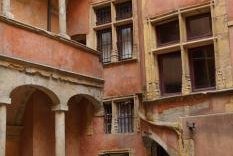
The charm of Lyon is the lively atmosphere and the varied architecture from different periods, and moreover: interesting museums and an excellent local cuisine. What else could you want for a weekend trip? In Lyon, you can find historic districts and buildings representing traces of urban settlement from 2000 years, from the Roman period to modern times. We spent four days in Lyon in June 2013, the city was our base for visiting the Le Corbousier sites in Firminy and Eveux-sur-Arbresle and the starting point for our round trip through Southern France. The WHS spreads over a wide area and comprises the quarters of Croix-Rousse, Presqu’île, Vieux Lyon, and the Fourvière hill. We started exploring the city at the Croix-Rousse hill. The multi-storey houses are from the 19th Century and were the homes and workshops of the silk workers. The apartments have been specifically created for the silk weavers: high rooms with enough space for the looms and large windows for plenty of natural light. The view from a Saône bridge nicely shows the window front of the building ensemble upwards the Croix-Rousse hill. Today it's a lively neighbourhood with some fashionable shops and design workshops, eg in the Passage Thiaffait, but in other parts also with run-down houses and shabby corners. Just around the corner of our hotel was one of the most famous 'traboules' (passageways of the silk weavers): La Cour des Voraces (place Colbert 9) with a six-floor stairway in the courtyard. It was the refuge of the silk workers during the uprisings in the mid of the 19th Century. Other interesting places are the Montée de la Grande Côte, a street that leads from the Plateau de la Croix Rousse down to Presqu'ile, and the “Maison aux 365 fenêtres“ at the place Rouville, where you have also a nice view to the Fourvière Basilica. Vieux-Lyon, the oldest district in Lyon, is a network of paved streets and small squares, with picturesque Renaissance buildings, all connected by a second network of passageways and courtyards. It was great fun to explore these traboules. We had a printed map from LyonTraboules, but some of the indicated doors were closed (or we were unable to find the right entrance). Thus, very soon we gave up to follow the suggested route on the map. Instead, we followed the track of some of the many guided tours. The best examples of traboules are in the rue Juiverie, between rue Saint-Jean and rue de Gadagne, and - not to be missed - the Tour Rose with a huge spiral staircase in rue du Bouef no.16. Inevitably, the stroll through Vieux-Lyon ends at the Cathedral Saint-Jean. The interior is not very impressive, the most interesting is the astronomical clock. After a short lunch break (French 'fast food' at the Boulangerie du Palais), we went up to the Fourvière hill, and - sportsmanlike - we took the steep stairways at the end of rue du Bouef. The Fourvière Basilica is unique in almost every respect and worth a visit. Ian's review aptly described the interior: "ludicrous" and "garish". Also worth seeing are the remains of the Roman theatres nearby, though they were less impressive than those we visited a few days later in Arles and Orange. It started to rain when we arrived there – lucky coincidence, because we decided to visit the Gallo-Roman Museum. From the outside rather inconspicuous, it turned out to be one of the best of its kind that I have ever visited. The highlights are the many large and well preserved mosaics. And finally: the Presqu'ile district between Rhône and Saône, with broad boulevards and wide squares, like the huge Place Bellecour or the Place des Terreaux. And you'll find shopping streets, restaurants (bouchons), and the ubiquitous traboules. The most beautiful examples: at the Musée de l'Imprimerie and in rue Mercière (photo). I would also confirm the recommendation by other reviewers for the Brasserie Georges, because of the Art Deco decoration and also because of the very good local food. If you have time left, there are fine examples of modern architecture in the outskirts of Lyon: the Gratte-Ciel neighbourhood with an Art-Deco town hall and theatre in Villeurbanne, the Saint-Exupéry TGV station by Santiago Calatrava, or buildings by Renzo Piano and Mario Botta. Maybe no must-see, but worthwhile if you are interested in modern architecture. And another attraction is under construction: the Musée Confluence by the Vienna architects Coop Himmelb(l)au (opening planned for 2014). All in all, we spent enjoyable days in Lyon, it was a great prelude of our trip to Southern France.
Comments
No comments yet.
